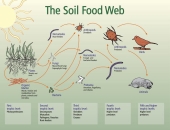posted 12 years ago
As soon as I bought this place a drought began which lasted nearly 3 years. The leaves in the woods out back were 6 inches deep in places and bone dry. Without the moisture, there was almost no decomposition and the leaves piled up. It was a tinderbox. Fire safety is an issue to be sure. Removing at least some of the deep leaf layer can be prudent to mitigate risk.
The duff layer is a key element to the forest ecosystem, removing all of it will be disruptive. Fortunately, the duff is renewable if the trees are not clear cut, but it takes several years to decades to return to normal, depending on how much of this renewable resource is harvested.
Harvesting the soil of a forest floor was a common practice before the days of chemical fertilizers. Farmers would go into the woods and start digging, filling cart after cart with the top foot or two of soil to spread on their cultivated fields. This is essentially strip mining. A couple of centuries ago, when the continent was covered with forest, space had to be cleared for roads and homes. I can see harvesting the soil under these areas as being acceptable. Nowadays, the trees are gone. Forests have been cut down for timber and fuel, and relegated to nature preserves and low spots on the back 40. Preserving what's left is paramount.
With that said, I think some soil harvesting can be done, but sound judgement is advised.
That 6 inches of leaves I had out back needed attention. Near the house for about 50 feet I gathered up most of the loose material. I did it in the late fall, when the soil would be covered shortly with a fresh, albeit thin, layer of fallen leaves. The idea here was to minimize soil exposure to sun and elements and allow the decomposition cycle to continue. A rake will handle much of the loose material. At times I used a pitchfork. There is a point where the undecomposed top layer becomes partially decomposed litter. This lower layer starts to be mixed with the soil and roots and is not as easy to rake up. I left that in place as much as was practical.
Harvesting the soil from the floor can be done in moderation, but strip mining is not the way to go. This begs the question of how much can be gathered without disruption. If I were putting in a new building, I'd take all of it under the construction area. Looking at the way the forest floor builds with leaves and fallen branches, I think the branches offer a hint of how wide an area can be harvested. I come up with a few feet wide being about as big as I'd want to go, maybe 4-6 feet. Digging a pit 5 feet wide, 5 feet long, a foot deep leaves a good sized scar in the forest. Remediation would need to be part of the project. Filling that gash with logs and branches, leaves, and perhaps some green material would give it a good start towards healing. For the next pit, the height of the trees offers a reference. 50 foot tall trees, give it a 50 foot distance before you dig another pit.
Doing the math, a 50x50 area is 2500 sqft. A 5x5 hole is 25 sqft. The hole is 1% of the area. It would take 100 years to harvest all that soil. If it takes 100 years for that 1 foot deep hole to be replenished, that would be the maximum rate of harvest. Bear in mind, forests are slow, even with remediation efforts in place.
For all the effort and disruption, it would be a shame to waste a bit of that soil.
Seed the Mind, Harvest Ideas.
http://farmwhisperer.com






 1
1
















 1
1








 1
1




































 1
1













